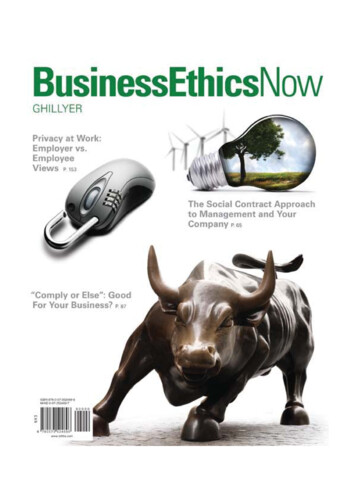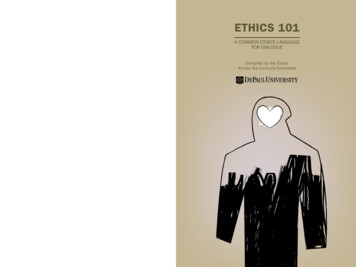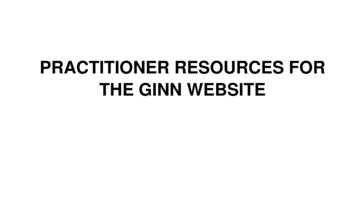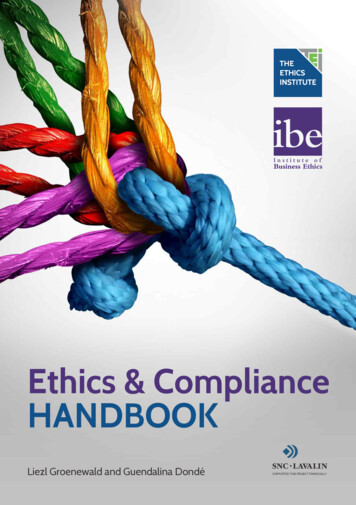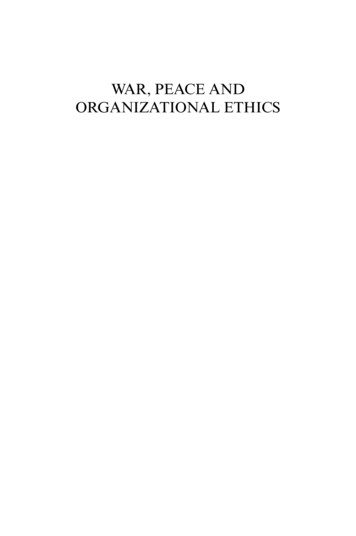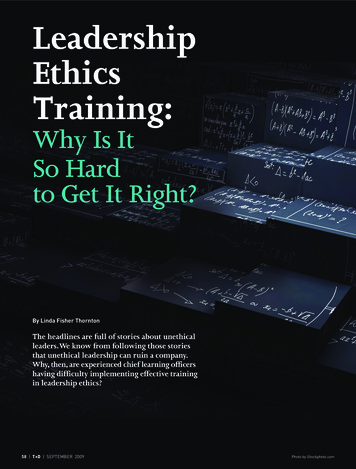
Transcription
LeadershipEthicsTraining:Why Is ItSo Hardto Get It Right?By Linda Fisher ThorntonThe headlines are full of stories about unethicalleaders. We know from following those storiesthat unethical leadership can ruin a company.Why, then, are experienced chief learning officershaving difficulty implementing effective trainingin leadership ethics?58 T D SEPTEMBER 2009Photo by iStockphoto.com
The national news has featuredstories about corporate greedand irresponsibility, and a largepercentage of performance improvement professionals are being asked toimplement companywide leadershipethics training. The time is right tomake ethical leadership a central themeduring leadership conversations and inleadership development programs.The Fuqua/Coach K Center onLeadership and Ethics (COLE), inpartnership with John Wiley and Sons,conducted its first annual survey of205 executives of public and privatecompanies. The leadership skills ratedmost important were promoting an ethical environment acting with authenticity interpreting the competitiveenvironment developing trust demonstrating optimism andenthusiasm.The COLE research also reported ontime spent on leadership development:“We found that most senior executivesspend less than 25 percent of theirtime on leadership development.While this is not a surprising findingfor CEOs and presidents of companies,we were surprised to learn that manyexecutives also reported that theirappointed chief learning officer andhead of leader development were notspending more time developing theiremployees’ leadership skills.“Another intriguing finding wasthe positive correlation between theamount of time spent on leadershipdevelopment by the CLO or the headof leader development and the firm’sreported financial performance. Thus,while we wouldn’t expect CEOs todevote most of their time to leaderdevelopment, we would expect CLOsand heads of leader development to doso—especially when spending more timetranslates into bottom line results.”Leadership ethics is a top concern,and leadership development positivelyaffects the bottom line. Why, then,aren’t we helping leaders deal withethical dilemmas?Why is it so hard to do?There are a variety of reasons whyCLOs are finding that the leadershipethics problem is not easily solved:The definition of leadership ethicsis still unclear; its scope is broadening, making it a moving target; ethicsis hard to talk about; and the mostuseful leadership ethics programs arecompany-specific.So, we have an unclear topic that isin flux, on a subject that is itself a grayarea. We have a general discomforttalking about the subject, and an offthe-shelf training program isn’t goingto fix the problem.The definition of leadership ethicsis evolving. So what do leaders needto know? There is disagreement amongexperts and practitioners about whatresponsible and ethical leadership evenincludes. Here we are, as learning professionals, trying to help business leaderswho deal with a wide range of stakeholders that compete for their attention—thefinancial bottom line of the company,employees, consumers of products orservices, and the community.Why is there no formula for resolving ethical issues in a multistakeholderenvironment? Ethical leadership is difficult to define because It lives at the intersection of thefields of leadership, business ethics,decision-making, and corporatesocial responsibility. Thought leaders in thevarious fields do not agree ona practical definition. It takes the discussion of leadershipinto moral territory. How you define it may varydepending on your worldviewand leadership values. The principles vary dependingon the source.SEPTEMBER 2009 T D 59
LEADING THE CONVERSATION IN OUR ORGANIZATIONSHere are some questions that may help you define ethical issues and appropriate leader behaviors in the contextof your organizational values: What are the specific ethical behaviors that are required of all organizational leaders? What are the consequences if they don’t behave ethically? What are the situations that people encounter that could lead them into a grey area? How should those grey areas be handled? What does it look like when leaders perform according to the organization’s stated values? What does it look like when they don’t? How should people make decisions when they encounter difficult situations? Where might our leaders fall into grey areas while implementing our goals and values? What are areas where we will not tolerate compromise? What are areas of flexibility? Where do we need to clarify our mission and values, to make it clear that we are an ethical organization,and ethics is not negotiable?How can we more effectively recruit, recognize, and retain ethical leaders? There are many academic articleson the subject, but there are fewpractical tools. To be implemented in organizations, ethics has to be discussedin the context of effectivenessand results.the planet. In other words, leaders areexpected to perform well, while makingchoices that do not harm groups nottraditionally considered constituents ofthe organization. It is difficult for leaders to succeed in an area that is evolving rapidly and is not well defined.The scope of leadership ethics isbroadening. Leadership ethics usedEffective leadership ethics programs are company-specific. I amto be about honesty, integrity, fairness,following rules and laws, and beingtrue to your values. Now, in the globalmarketplace, with fierce competitionfor business and resources, the scope ofproblems that can occur in leadershipethics has expanded exponentially.The global scope means that theissues we encounter may involve thewidely differing values, rules, and lawsof multiple companies and cultures.The way that we define “leadershipethics” has to be different in this newmarketplace and has to incorporatemore than individual values.To get a feel for the broader scopeof how we now define an ethical company, think beyond simple compliancewith laws, to include responsible corporate citizenship, achieving transparency in communication, and protecting the environment.The table shows how the scopeof leadership ethics has expanded toinclude issues that go far beyond legalrequirements, honesty, and fairness,to include how what we do in organizations affects profits, people, andseeing more frequent blog posts fromCLOs seeking packaged leadershipethics programs to purchase for theirorganizations. A packaged programcan generate understanding, awareness, and knowledge about ethicalissues in leadership. By going fartherand asking the hard questions aboutethical leadership in the context of ourorganization, though, we provide leaders with real direction about how tomake day-to-day decisions.If we are having difficulty definingethical leadership, imagine how a linemanager feels when faced with a toughdecision and a tight deadline. No packaged program can help your leadersunderstand the specific boundaries ofethical leadership in your organization.Creating those boundaries is mademore difficult because ethical leadership is hard for people to talk about.60 T D SEPTEMBER 2009Ethics is hard to talk about. AsCLOs, we are not particularly comfortable dealing with an area of performance that crosses into moral territoryand is not clearly defined. Leadershipethics is all about how people handlesituations when they have more thanone possible path to choose from.Many of those paths are legal, but notethical. When we ask leaders to avoidmaking decisions that, though legal,would be considered unethical, we aredefining moral behavior.That can seem like a very trickyrole for the CLO. But who else in theorganization is going to lead thisconversation? We are more aware ofthese issues than other leaders in theorganization. We are skilled at askingquestions that uncover performancegaps and priorities. We are uniquelypositioned to lead the difficult conversations that define leadership ethics inour organizations.Isn’t it the ethics officer’s job? Whathappens when the responsibilities fordeveloping ethical leadership withinthe organization are not clearly defined?Some CLOs may think, “Isn’t it the ethicsofficer’s job to worry about training onleadership ethics?” David Gebler, in hisarticle “The End of Ethics? Going Beyond Compliance Requirements,” clarifies how the ethics officer fits in:“There is a challenging paradoxin that the successful ethics officerof tomorrow will be the one that hasthe smallest organizational footprint.Their success will be in having otherfunctions, such as organizational development, HR, and communications,be successful.”
While the ethics officer can provide support, CLOs are still in the bestposition to lead the organizationalconversations that define ethical leadership. Senior leaders may be callingfor training but may not yet be able toclearly articulate what ethical leadership looks like within the organization.Turning the answers intoleadership developmentEffective leadership ethics development isn’t a mandatory “program” forleaders that is offered in multiple sessions at central locations. It’s a way ofoperating that touches many aspectsof organizational performance. Thegeneral wisdom is that leadershipethics should be an integrated partof every training program that leaders participate in. That integrationdemonstrates that ethical behavior isnot optional, but is an ongoing partof the required leadership role. Theintegration allows facilitators and leaders to talk through difficult scenarioseach time they are together, building ashared understanding of appropriateand inappropriate behavior.Case studies that describe realsituations that have happened in theorganization (with the names and details changed to protect privacy) allowleaders to tackle tough ethical issuestogether in small group discussions.By providing a forum for conversationsabout ethical leadership within the organization, we are providing emergingboundaries for how leaders implementtheir ongoing responsibilities. Theseboundaries, as they are clarified, enable the organization and its leaders to have a dialogue about priorities,values and appropriate behavior move in the same direction, knowing that their chosen behavior isresponsible and appropriate identify performance that fallsoutside of the boundaries deal with and resolve performancethat falls outside of the boundariesbefore it erodes organizationalperformance and credibility.performance systems that require andreward ethical behavior. To build anethical organization over time, CLOscan work with leaders throughout theorganization to build organizationalcompetence in areas that support effective communication and leadership.This will make it easier to identify and correct unethical behavior(think about the headlines and lessonslearned as you review this list that canget you started): E mployees who ask tough questions of leaders are praised, notpunished or ignored. L eaders are evaluated on how theycommunicate and lead, not just ontheir bottom line results. E mployees are screened for ethicalbehavior before they are hired. P erformance problems are corrected quickly, so that they are notgiven time to be considered acceptable by others. R ecognition is given to leaderswho achieve financial goals ethically, while engaging employeesand using responsible leadership(not to leaders who achieve resultsat the expense of employees, customers, or organizational values).The CLO, as the most knowledgeable performance leader in the organization, is a critical player in the questfor the ethical organization. We mustcheck ourselves (are we modeling whatwe expect of others?) and take the leadLeadership ethics usedto be about honesty,integrity, fairness,following rules andlaws, and being true toyour values. Now, in theglobal marketplace,with fierce competition for business andresources, the scope ofproblems that can occurin leadership ethics hasexpanded exponentially.in generating the critical conversationsthat will set the stage for ethical leadership in the years ahead. T DLinda Fisher Thornton is president of FisherThornton Consulting, and former seniorvice president of training at Central FidelityBank in Richmond, Virginia. She teachesleadership at the University of Richmond;lthornt2@richmond.edu.INTERESTED IN ORDERING E-PRINTS?Would a digital version of this article be agreat fit for your next course, presentation, orevent? Are you interested in e-prints of severalT D articles on a specific topic? Email us thespecifics at eprints@astd.org to learn more.Building an ethical organizationWhile making ethics an integrated partof every leadership development program is a good start, ethical leadershipis best supported by company-widePhoto by iStockphoto.comSEPTEMBER 2009 T D 61
TRAINING DEVELOPMENTI want to subscribe for only to T D magazine—12 monthly issuesthat keep me at the forefront of workplace learning and performance.YES!r Individual rate 129 ( 195 outside the U.S.)r Institutional rate 150 ( 216 outside the U.S.)TD0833Order InformationName:Title: Company:Address: City:State/Province: Zip/Postal Code:Country: Email:Phone: Fax:Check One:VISA 99 (USA) 165 (Outside the US)MasterCardAmexDiscoverCheck (USD)(Payable to T D)Card Number: Expiration DateSignature:Fax this form to 1.703.683.9591 OR Mail to:T D, P.O. Box 1567; Merrifield, Virginia, 22116-9812, USAOrders processed within three business days.If you have questions, please contact subscriberservice@astd.orgPrices valid through 12/31/2010. If you should wish to cancel your subscriptionfor any reason, you will receive a refund on all unmailed issues.Your subscription to T D may be a tax deductible business expense.Please allow 6 to 8 weeks to receive your first issue.T D is published by the American Society for Training and Development (ASTD)050902.63250Order online at store.astd.orgPhone: 1.800.628.2783 (1.703.683.8100 outside the US)
make ethical leadership a central theme during leadership conversations and in leadership development programs. The Fuqua/Coach K Center on Leadership and Ethics (COLE), in partnership with John Wiley and Sons, conducted its first annual survey of 205 executives of public and private companies. The leadership skills rated most important were
